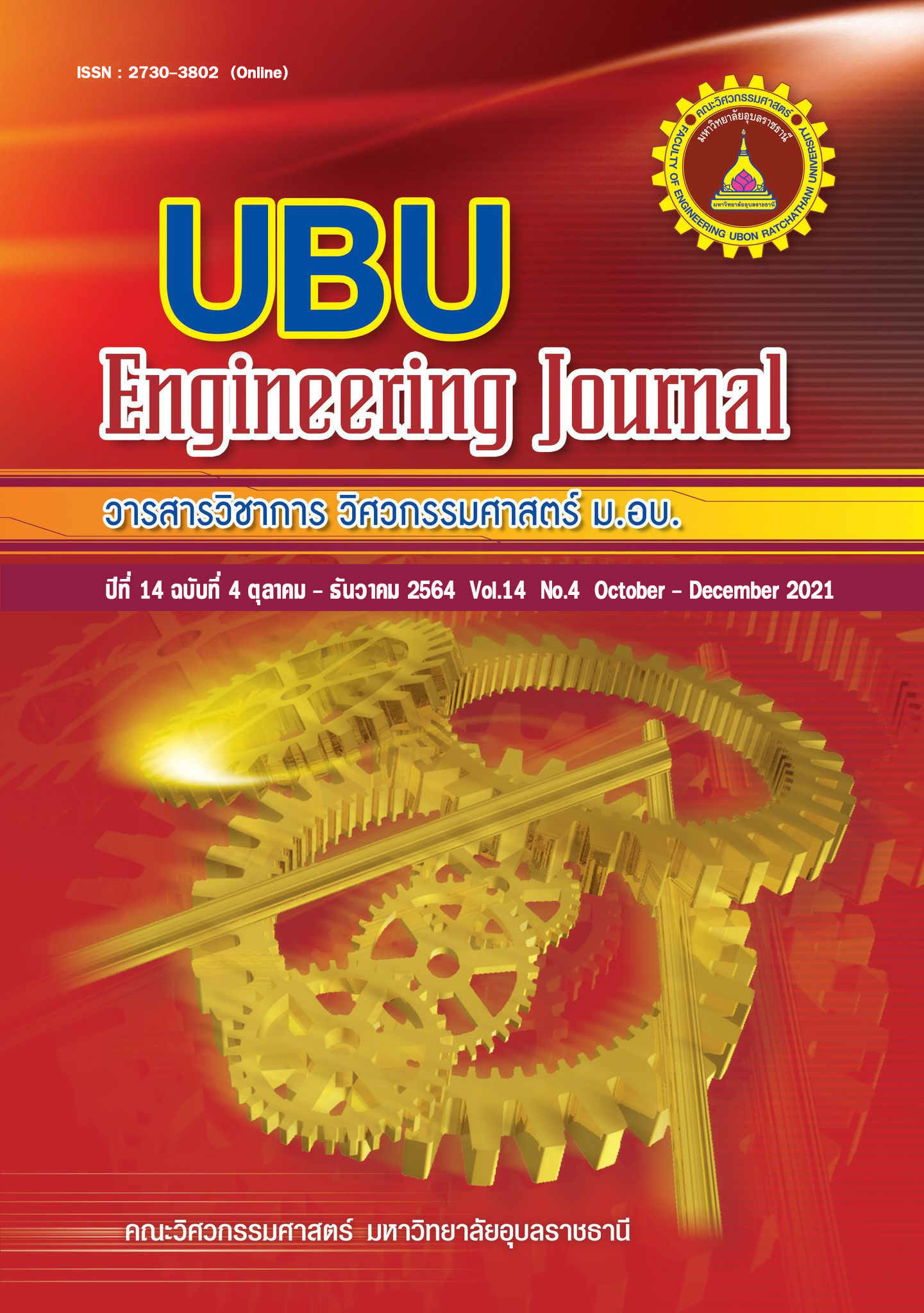Removal of Trihalomethanes (THMs) Precursors in Surface Water and Effluent by Magnetic Ion Exchange (MIEX) Resin
Main Article Content
Abstract
แหล่งน้ำดิบสำหรับการผลิตน้ำประปาส่วนใหญ่ คือ น้ำผิวดิน ซึ่งมีแนวโน้มที่จะถูกปนเปื้อนด้วยน้ำเสียและน้ำทิ้งจากกิจกรรมต่าง ๆ ของมนุษย์ ซึ่งในน้ำทิ้งนี้มีสารอินทรีย์ที่มีคุณสมบัติแตกต่างจากสารอินทรีย์ธรรมชาติทั่วไป โดยสารเคมีฆ่าเชื้อโรคในระบบผลิตน้ำประปาสามารถทำปฏิกิริยากับสารอินทรีย์ละลายน้ำก่อให้เกิดสารพลอยได้จากการฆ่าเชื้อโรค (Disinfection by-products, DBPs) ซึ่งเป็นสารก่อให้เกิดมะเร็ง สารกลุ่ม DBPs ที่สำคัญและถูกระบุไว้ในมาตรฐานคุณภาพน้ำประปาของประเทศไทย คือ สารกลุ่มไตรฮาโลมีเทน (THMs) ดังนั้น งานวิจัยนี้มีวัตถุประสงค์เพื่อศึกษาผลกระทบของสารอินทรีย์ในน้ำทิ้งที่มีต่อการเกิดสารพลอยได้กลุ่ม THMs และการกำจัดสารตั้งต้นของสารกลุ่ม THMs โดยใช้เรซินแลกเปลี่ยนประจุที่มีคุณสมบัติเป็นแม่เหล็ก (Magnetic ion exchange resin, MIEX) สองรุ่นคือเรซิน MIEX DOC และ MIEX GOLD โดยใช้น้ำตัวอย่างจากแม่น้ำพอง จังหวัดขอนแก่น และเก็บตัวอย่างตามระยะทางแตกต่างกัน 6 จุด แต่ละจุดเก็บน้ำตัวอย่างถือเป็นตัวแทนของน้ำที่ได้รับผลกระทบจากกิจกรรมรอบข้างตลอดลำน้ำ ทั้งการเกษตรกรรม ชุมชน รวมไปถึงจุดที่ได้รับน้ำทิ้งจากโรงงานอุตสาหกรรมที่อาจมีปริมาณสารอินทรีย์ในน้ำทิ้งสูงและส่งผลกระทบต่อแหล่งน้ำธรรมชาติได้ พารามิเตอร์ที่ทำการตรวจวัดได้แก่ คาร์บอนอินทรีย์ละลายน้ำ (DOC), ไนโตรเจนละลายน้ำ (TDN), Specific UV absorbance (SUVA) และศักยภาพในการเกิดสารกลุ่ม THMs (THM-FP) จากผลการศึกษา พบว่า สารอินทรีย์ในน้ำทิ้งจากอุตสาหกรรมกระดาษมีความสามารถในการทำปฏิกิริยากับคลอรีนเกิดเป็นสารกลุ่ม THMs สูงกว่าสารอินทรีย์จากจุดอื่นๆ ในแม่น้ำพอง โดยค่า THM-FP จำเพาะ ของสารอินทรีย์ (THM-FP/DOC) มีค่าอยู่ที่ 84.7 µg/mg สำหรับน้ำทิ้ง และมีค่าอยู่ในช่วง 55.3-61.3 µg/mg สำหรับน้ำผิวดิน ประสิทธิภาพการกำจัด DOC ของเรซิน MIEX DOC และ MIEX GOLD อยู่ในช่วง 54-61% และ 50-62% ตามลำดับ และสามารถกำจัด TDN ได้ในช่วง 12-42% และ 13-53% ตามลำดับ เรซิน MIEX DOC และ MIEX GOLD สามารถกำจัดสารตั้งต้นของ THMs ได้ในช่วง 59-75% และ 61-84% ตามลำดับ ทั้งนี้เรซินทั้งสองชนิดแสดงพฤติกรรมการเลือกกำจัดสารอินทรีย์กลุ่มอะโรมาติกซึ่งเป็นสารตั้งต้นของ THMs จากผลการศึกษาดังกล่าวสามารถสรุปได้ว่าเรซิน MIEX GOLD มีประสิทธิภาพการกำจัด TDN และสารตั้งต้นของ THMs สูงกว่าเรซิน MIEX DOC เนื่องจากมีขนาดรูพรุนที่ใหญ่กว่า มีความพรุนสูงกว่า และมีพื้นที่ผิวต่อปริมาตรเรซินสูงกว่า
Article Details
References
[2] US EPA. Six-Year Review 3 Technical Support Document for Disinfectants/Disinfection Byproducts Rules [Internet]. 2016.
[3] US EPA. National Primary Drinking Water Regulations: Stage 1 Disinfectants and Disinfection Byproducts Rule. 2001.
[4] Leenheer JA, Croué J-P. Peer reviewed: Characterizing aquatic dissolved organic matter, Understanding the unknown structures is key to better treatment of drinking water. Environ Sci Technol. 2003;1:18A-26A.
[5] Singer PC, Bilyk K. Enhanced coagulation using a magnetic ion exchange resin. Water Res. 2002 Sep;36:4009–22.
[6] World Health Organization. Guidelines for Drinking-water Quality. 4th ed. World Health Organization, editor. World Health Organization. Geneva, Switzerland; 2011.
[7] Krasner SW, Westerhoff P, Chen B, Rittmann BE, Nam S-N, Amy G. Impact of wastewater treatment processes on organic carbon, organic nitrogen, and DBP precursors in effuent organic matter. Environ Sci Technol. 2009;43(8):2911–8.
[8] Neale PA, Schäfer AI. Magnetic ion exchange: Is there potential for international development? Desalination. 2009 Nov 15;248:160–8.
[9] Gibson A, Golubovic S. MIEX Gold resin: Demonstration at Aireys inlet Water: Water J Aust Water Assoc. 2015;42(2):50–2.
[10] Rajca M, Włodyka-Bergier A, Bodzek M, Bergier T. MIEX® DOC process to remove disinfection by-product precursors. Desalin Water Treat. 2017;64:372–7.
[11] Gan X, Karanfil T, Kaplan Bekaroglu SS, Shan J. The control of N-DBP and C-DBP precursors with MIEX®. Water Res. 2013;47(3):1344–52.
[12] Jutaporn P, Armstrong MD, Coronell O. Assessment of C-DBP and N-DBP formation potential and its reduction by MIEX® DOC and MIEX® GOLD resins using fluorescence spectroscopy and parallel factor analysis. Water Res. 2020;172:1–11.
[13] Jutaporn P, Singer PC, Cory RM, Coronell O. Minimization of short-term low-pressure membrane fouling using a magnetic ion exchange (MIEX®) resin. Water Res. 2016;98:225–34.
[14] Boyer TH, Singer PC. A pilot-scale evaluation of magnetic ion exchange treatment for removal of natural organic material and inorganic anions. Water Res. 2006 Aug;40(15):2865–76.
[15] Summers RS, Hooper SM, Shukairy HM, Solarik G, Owen D. Assessing DBP yield: uniform formation conditions. J Am Water Work Assoc. 1996;88(6):80–93.
[16] Tongchang P, Kumsuvan J, Phatthalung WN, Suksaroj C, Wongrueng A, Musikavong C. Reduction by enhanced coagulation of dissolved organic nitrogen as a precursor of N-nitrosodimethylamine. J Environ Sci Heal - Part A Toxic/Hazardous Subst Environ Eng. 2018;53(6):583–93.
[17] Musikavong C, Inthanuchit K, Srimuang K, Suksaroj TT, Suksaroj C. Reduction of fractionated dissolved organic matter and their trihalomethane formation potential with enhanced coagulation. ScienceAsia. 2013;39:56–66.
[18] Pokhrel D, Viraraghavan T. Treatment of pulp and paper mill wastewater - A review. Sci Total Environ. 2004;333(1–3):37–58.
[19] Slunjski M, Cadee K, Tattersall J. MIEX ® Resin Water Treatment Process. In: Aquatech Amsterdam. Amsterdam, Netherlands; 2000.
[20] Laolertworakul W, Jutaporn P, Tungsudjawong K, Leungprasert S, Khongnakorn W. Assessing Trihalomethanes (THMs) Formation Potential in a Water Supply Plant Using Fluoresecence Exitation-Emission Matrix. KMUTT Res Dev J. 2020;43(3):257–75.
[21] Drikas M, Dixon M, Morran J. Long term case study of MIEX pre-treatment in drinking water; understanding NOM removal. Water Res. 2011 Mar;45:1539–48.
[22] Na-Phatthalung W, Musikavong C, Suttinun O. The presence of aliphatic and aromatic amines in reservoir and canal water as precursors to disinfection by-products. J Environ Sci Heal - Part A Toxic/Hazardous Subst Environ Eng. 2016;51(11):900–13.
[23] Fabris R, Lee EK, Chow CWK, Chen V, Drikas M. Pre-treatments to reduce fouling of low pressure micro-filtration (MF) membranes. J Memb Sci. 2007 Feb;289:231–40.
[24] López-Ortiz CM, Sentana-Gadea I, Varó-Galvañ PJ, Maestre-Pérez SE, Prats-Rico D. Effect of magnetic ion exchange (MIEX®) on removal of emerging organic contaminants. Chemosphere. 2018;208:433–40.
[25] Panyapinyopol B, Marhaba TF, Kanokkantapong V, Pavasant P. Characterization of precursors to trihalomethanes formation in Bangkok source water. J Hazard Mater. 2005;120:229–36.

